Two Maruti Suzuki models, one each from Hyundai, Datsun in Global NCAP's latest set of crash tests
Global NCAP tested the Maruti Suzuki Ertiga, Maruti Suzuki Wagon R, Hyundai Santro and the Datsun Redigo in its sixth round of #SaferCarsForIndia campaign.
The sixth round of crash tests of cars from India by Global NCAP, the automotive safety watchdog supported by FIA Foundation and Bloomberg Philanthropies, saw results ranging from three stars to one star for adult occupant protection. The data released today reveal the safety quotient for four Made-in-India models. The models tested are the Maruti Suzuki Ertiga, Maruti Suzuki Wagon R, Hyundai Santro and the Datsun Redigo. These models do meet Indian safety regulations that saw some modifications last October.
Global NCAP crash tests cars at 64kph. That is 8kph higher than the speed at which cars are tested for safety certification in India. Global NCAP argues that its test speed is to make cars offer a higher safety margin. Speaking to Autocar Professional, Alejandro Furas, technical director, Global NCAP, says, "It's not uncommon in many places in India that cars drive at speeds of 60kph or higher." On the star rating system he says, "A car with a lower occupant safety score than another may get a higher star rating if the crash dummy injury point is less fatal than in the other car where a dummy may have received less injuries but may have got hurt in a very critical part like head or chest, which can be fatal."
Global NCAP crash test: everything you need to know
The #SaferCarsForIndia campaign was launched by Global NCAP in 2014 with the objective of promoting safer vehicles in the country. Between 2014 and 2018 Global NCAP has completed more than 29 safety assessments which have acted as an important catalyst in the safety improvement of Indian cars. Global NCAP says it chose the entry-level version of each model and as a result only the Ertiga was fitted with at least two airbags as standard while the other models offered only a driver airbag. The results highlight significant differences in adult occupant protection in cars that meet the latest Indian government vehicle technical regulations.
Commenting on the results David Ward, CEO and President of Global NCAP said, “The latest results in our #SaferCarsforIndia crash tests show a mixed safety performance, and disappointingly, there are no five-star performers. The Maruti Suzuki Ertiga achieves a creditable three stars for both adult and child occupant protection, but it’s obvious to us that more can and should be done to improve overall protection levels for cars sold in the market. The Indian government’s crash test standards are clearly helping to eliminate any new zero-star cars from the market, and we will continue to work with them to ensure the push of regulatory requirements is complimented by the pull of consumer awareness, encouraging the demand for ever higher levels of safety.”
Maruti Suzuki Ertiga scores three stars
The Ertiga MPV in its new avatar is a popular choice amongst Indian consumers, thanks to its spacious offering thoughtful features and a value-for-money package. The Ertiga achieved three stars for adult occupant protection and three stars for child occupant protection.

The MPV offers two frontal airbags as standard. Its structure was rated as a borderline unstable performance, which can and should be improved. Its footwell area was rated as unstable and pedals displacement showed risks to the lower legs of the driver. Head and neck protection for adult occupants was good. Chest protection for passenger was good and driver chest received marginal protection.
The passenger pretensioner failed to work properly. Child occupant protection showed poor results for the 18-month-old dummy with the CRS installed forward-facing while global best practice indicates a rearward-facing position offers rearward facing protection for this age group.
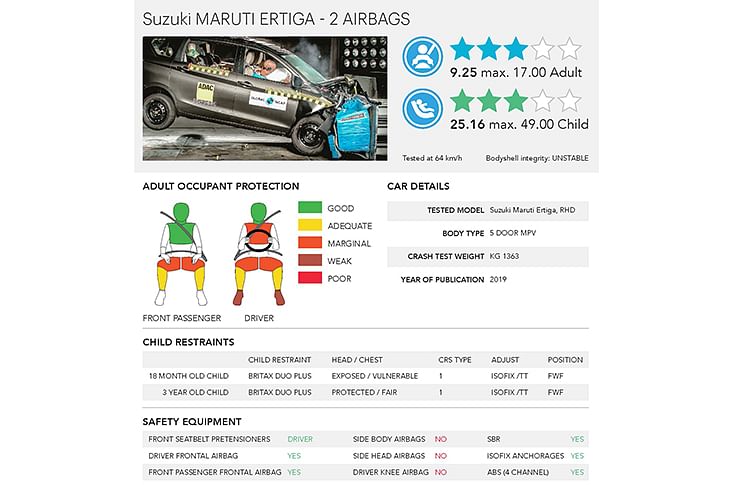
The Ertiga offers standard ISOFIX anchorages. Overall, it achieved three stars for child occupant protection. The Ertiga comes with two Seat Belt Reminders (SBR) in the front seats as a standard. Global NCAP says ‘it is surprising that this car is not offering 3-point belts for all occupants.’
Maruti Suzuki Wagon R manages two-star safety rating
The second product from the country’s largest carmaker and one of the most popular selling cars in the country the Wagon R achieved two stars for adult occupant protection and two stars for child occupant protection.

The vehicle offers only a driver frontal airbag as standard. Its structure was rated as unstable. Its footwell area was rated as unstable and pedal displacement showed some risk to the lower legs of the driver.
Head protection for adult occupants was good. Neck protection for driver was good and adequate for passenger. While, Chest protection was weak for both front passengers leading to limitations in the SBR points achieved by this model.
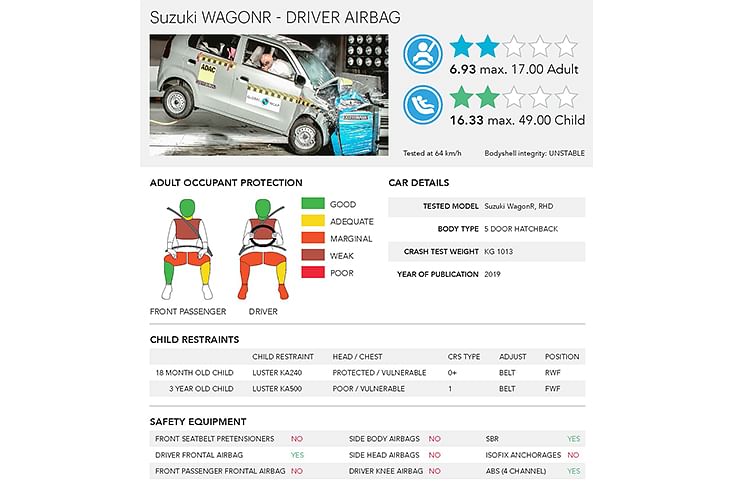
The child occupant protection showed poor results mainly for the 3-year old dummy as its Child Restraint System (CRS) broke during the impact and the head impacted the front seat. Chest protection for the 18-month old dummy was low despite being installed rearward facing. The WagonR offers standard two SBR in the front seats but its points were not considered for the final rating as the front passenger chest received weak protection. Global NNCAP noted that it was surprising that the car was not offering 3-point belts for all occupants.
Hyundai Santro gets two-star safety rating
The original tallboy and budget hatchback from Hyundai’s stable the Santro achieved two stars for adult occupant protection and two stars for child occupant protection.
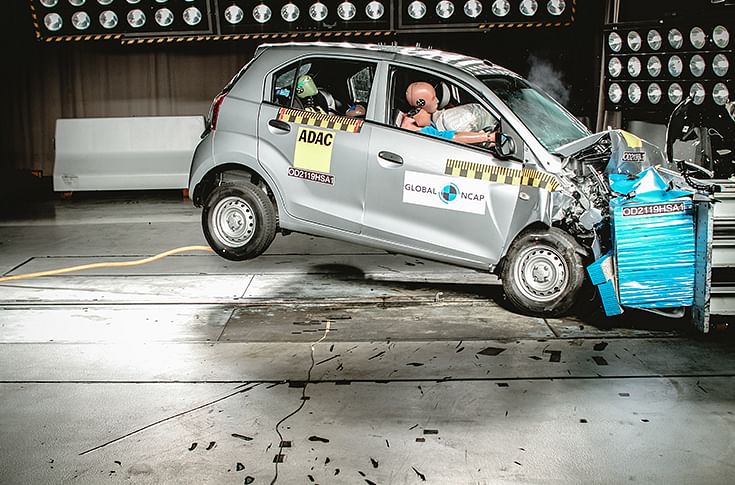
The Santro comes with only a driver frontal airbag as standard. Global NCAP rated its structure and footwell area as unstable. The head and neck protection for adult occupants was good, while chest protection was weak for the driver and marginal for the passenger leading to a limitation of the SBR points achieved by this model for the driver.
Global NCAP says in terms of child occupant protection the hatchback showed poor results mainly because the manufacturers did not recommend a CRS for the test. The dynamic performance was poor as the head of the 3-year old showed contact during the impact. There was limited protection for the 3-year old neck while the 18-month old received acceptable protection.
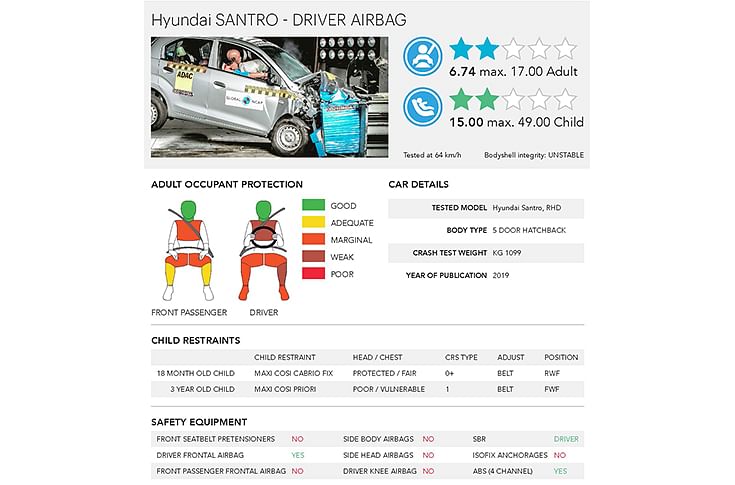
The Santro comes with a standard driver SBR but its points were not considered for the final rating as the chest of the driver received weak protection. GNCAP says it is surprising that this car is not offering 3-points belts for all occupants.
Datsun Redigo just one star
The fourth car tested by Global NCAP came from the budget brand of the Renault-Nissan Alliance, the Datsun Redigo achieved just one star for adult occupant protection and two stars for child occupant protection.
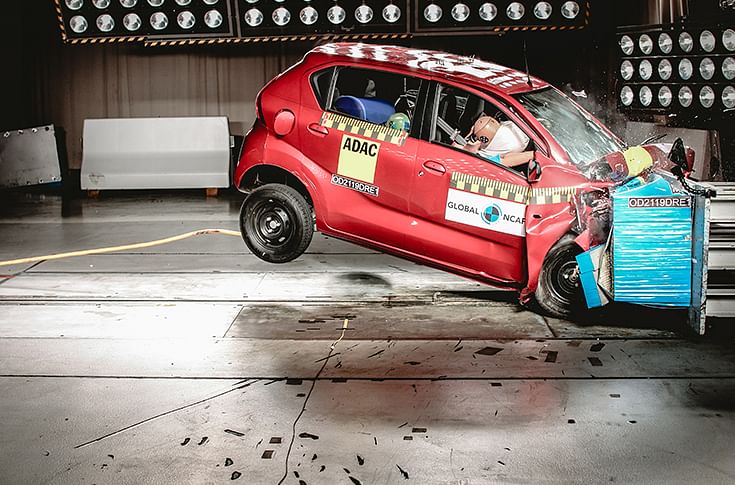
The RediGo comes with only a driver frontal airbag as standard. Its structure and footwell area were rated unstable. In terms of head protection for driver was adequate due to steering wheel displacements. The head protection for a passenger was good, driver and passenger neck protection were rated good too.
On the other hand, the car’s chest protection was rated poor for the driver and marginal for the passenger. Global NCAP says the poor protection of the driver's chest means that there is a high probability of life-threatening injuries. Poor protection for any of the critical body regions, in this case, the chest, limits the star rating to one star for the adults.
The Redigo does not offer SBR in the front seats and, even if it had, the result would remain a single star. The SBR points are limited as the chest is brown or red. Child occupant protection showed poor results mainly because of the contact of the head of the 18-month old with the front seat and for the exposed head of the 3-year old dummy during the impact.
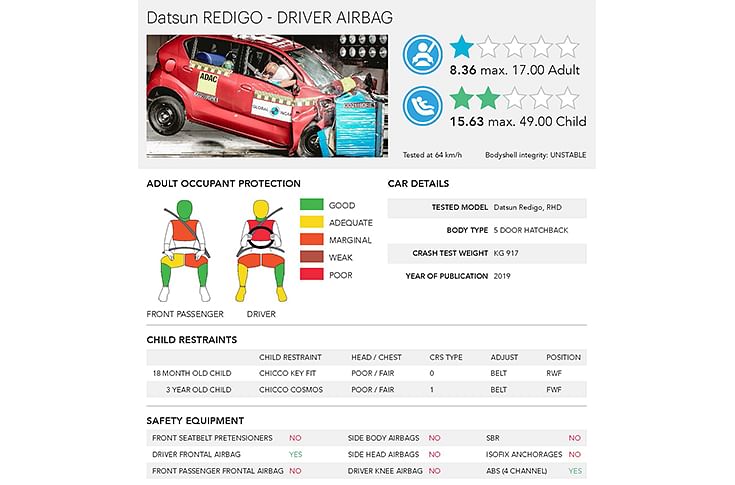
The static rear 3-point belts created difficulties in the proper and safe installation of a CRS. Global NCAP says it is surprising that this car is not offering 3-point belts with automatic retractors for all occupants.
Global NCAP awards a separate child safety rating to each car in order to highlight the different levels of protection vehicles provide to passengers on the rear seats. Global NCAP tests a combination of the car and that child seat recommended by the car manufacturer. Because the only safe way for young children to travel is properly restrained in a child seat, the assessment checks how compatible the car is with the child seats recommended by the manufacturer, as well as the protection provided in the crash test.
Global NCAP says the three tested vehicles offer ISOFIX as standard which is a desirable improvement however the different tests showed poor performances of the CRS in terms of child occupant protection. Airbags are not a substitute for seatbelts, passengers must always wear seatbelts. None of the models offered three-point seatbelt for all passengers. Lap belts in the middle position make it impossible to properly and safely install a CRS and offer much lower protection than a three-point belt for adults.
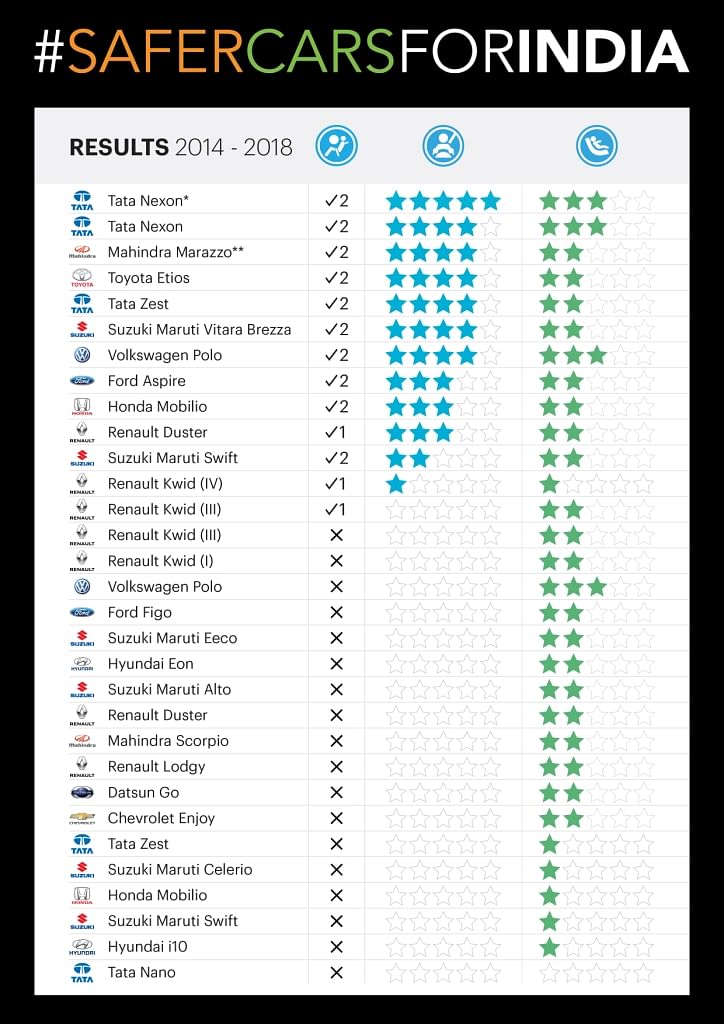
Also read: Global NCAP's safer cars for India mission so far
Made-in-India Honda Amaze gets 4-star rating in Global NCAP crash test
Tata Nexon first Indian car to get five-star Global NCAP rating, Mahindra Marazzo a close second
New Maruti Swift gets 2-star Global NCAP rating for adult safety
India-bound Citroen C5 Aircross gets 4-star Euro NCAP crash test rating
RELATED ARTICLES
Autoliv Plans JV for Advanced Safety Electronics With China’s HSAE
The new joint venture, which is to be located strategically near Shanghai and close to several existing Autoliv sites in...
JLR to Restart Production Over a Month After September Hacking
Manufacturing operations at the Tata Group-owned British luxury car and SUV manufacturer were shut down following a cybe...
BYD UK Sales Jump 880% in September to 11,271 units
Sales record sets the UK apart as the largest international market for BYD outside of China for the first time. The Seal...






 31 Oct 2019
31 Oct 2019
 22287 Views
22287 Views












 Ajit Dalvi
Ajit Dalvi




